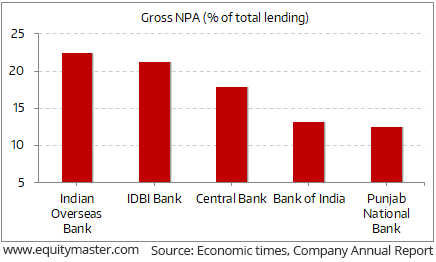Sensex Trades Marginally Lower; IT Stocks Witness Losses
Share markets in India are presently trading marginally lower. Sectoral indices are trading on a mixed note with stocks in the IT sector and power sector witnessing maximum selling pressure. Metal stocks are trading in the green.
The BSE Sensex is trading down 7 points (down 0.01%) and the NSE Nifty is trading up by 4 points (up 0.04%). The BSE Mid Cap index is trading flat, while the BSE Small Cap index is trading up by 0.1%. The rupee is trading at 64.05 to the US$.
In the news from banking sector, the government is looking to set up a new mechanism to speed up decisions regarding possible mergers of public sector banks (PSUs).
As per the news, this new mechanism will be in line with the alternative mechanism that has been adopted for strategic divestments.
One shall note that earlier this year, four state banks viz. Syndicate Bank, Canara Bank, Vijaya Bank, and Dena Bank made presentations to the finance ministry on their merger plans.
However, does it really make sense to merge public sector banks?
We don't think so. While it's true that only the fit ones should be allowed to survive, merging smaller PSU banks at this stage will make the situation even worse. Not only the merger will create cultural and autonomy issues to deal with, but will fail to address the problem of bad assets. It could even make the stronger bank suffer.
As Vivek Kaul, editor of Vivek Kaul's Diary, states that the merger of two public sector banks, will give us a bigger inefficient bank. As he writes, 'In this scenario, if banks are merged without the bad loan problem being solved, we will have a situation where problems of two banks are basically passed on to one bank. That doesn't make the situation any better.'
Perhaps it may make more sense to merge the PSU banks once the clean-up exercise is done.
One shall note that bad loans at PSU banks have only been rising, as can be seen from the chart below:
Rising Bad Loans at Indian Banks

Gross non-performing assets (GNPA) of Indian banks rose from 9.2% in September 2016 to 9.6% in March 2017. GNPA refers to the total value of loans on which interest and principal income has not been received by the bank for more than ninety days. For some banks, the ratio of GNPAs to total lending is more than 20%. This means more than Rs 20 out of every Rs 100 lent is at the risk of not coming back.
The RBI expects the average GNPA ratio to increase to 10.2% by March 2018. It indicated that if macroeconomic conditions worsen, this number could go up.
The problem of bad loans is indeed quite severe and when we compare it with other global peers it looks daunting.
Out of the ten major economies facing NPA problems, India is ranked seventh.
The overhang of bad debts has not only hit the bank's profitability, but has also restricted their loan book growth.
In the news from the Goods and Services Tax (GST) space, the GST Implementation Committee has taken a decision to extend the last date for payment of the GST for the month of July 2017 to 25th August 2017.
As stated in a leading financial daily, the date was extended as there was witnessed a technical glitch which held up filing of the GST return on 20th August - the last date for payment and filing of the simplified return of GST.
The Goods and Services Tax became the order of the day last month. And all these months we have been subjected to a relentless propaganda by the government and the supporters of the GST, on how it will change our world, only for good.
Our colleague Vivek Kaul has studied the finer aspects of the GST and predicted what could go right and wrong.
Disclaimer: Equitymaster Agora Research Private Limited (hereinafter referred as 'Equitymaster') is an independent equity research Company. Equitymaster is not an Investment Adviser. ...
more


